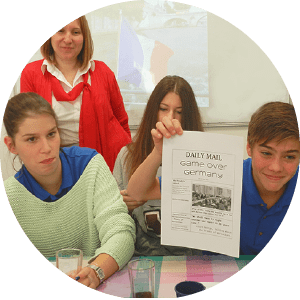HISTORY
Fresh perspectives on the past
Teaching 20th century history of international relations to 15 year olds could be a real challenge. For this reason it is important to try to bring history to life, and inspire students to relate to historical figures, who shaped the history of the world, in order to understand the complexity of their decisions. One way of achieving this is through introduction of decision making games and role plays, which help students identify with the persons living in the past times and understanding their specific worldview.
During history lessons at Savremena students had the opportunity to adopt a “new” identity and imagine that they were living through the most dramatic historical periods of the 20th century, such as the outbreak of World War Two or the height of the Cold War.
At the beginning of the lesson students were assigned different roles such as foreign policy expert to Soviet leaders during the times of decisive moments in history such as the Cuban Missile Crisis or the signing of the Nazi-Soviet Pact. The teacher served as a guide explaining diplomatic dilemmas and possible courses of action, while the students had to make decisions based on the interests and expectations of their imaginary persons.
Through these activities the students were able to understand how historical events develop and to practice their problem solving skills.
A reenactment of the Treaty of Versailles Conference and the events of 1919 accompanied by chansons and French “wine”
 One of the ways our students learned about the Versailles Conference was through a reenactment exercise in which, divided into three groups representing the victor states in WW1 - France, Russia and the UK, students selected a group leader that represented them in the conference. Other students had the chance to offer advice and suggestions to their representative during the discussion through the chat service.
One of the ways our students learned about the Versailles Conference was through a reenactment exercise in which, divided into three groups representing the victor states in WW1 - France, Russia and the UK, students selected a group leader that represented them in the conference. Other students had the chance to offer advice and suggestions to their representative during the discussion through the chat service.
Each group received guidelines in terms of the specific goals they should strive to achieve in the discussion to be awarded points. The group with the most points was declared the winner. The debate was heated, as was the original conference. Afterwards, students told their history teacher Sanja Bogdanović that they thoroughly enjoyed such a learning activity and that it helped them attain a better test score.
Since the students showed immense interest in the Versailles Conference, the following class they wrote a news article in the name of France, Germany and the UK, once again divided into three groups. The goal was to write a number of short newspaper articles examining and commenting on the treaty terms from the point of view of a French, German and English reporter. In that, students first explored actual news articles from that time to get a sense for the way the three representatives interpreted the Peace Treaty.
The third installment of this interesting workshop took place during the following lesson in the form of a simulation. Students simulated a discussion that took place on the 29th of June 1919 in a French cafe between a group of people from France, Germany and the UK who read their papers and discussed whether or not the Peace Treaty terms had been fair. The newspapers they used were in fact the articles students wrote during the previous lesson. Students read the articles as they listened to French chansons while sipping on apple and blackcurrant juice that symbolised wine and beer i.e. the national drinks of the said countries.


















